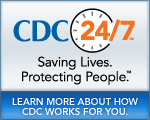MMWR – Morbidity and Mortality Weekly Report
MMWR News Synopsis for August 5, 2010
- Launching a National Surveillance System After an Earthquake — Haiti, 2010
- Policy Note: Rapid Establishment of a Disease Surveillance System after an Earthquake — Haiti, 2010
- Tobacco and Polytobacco Use — 13 States, 2008
There is no MMWR telebriefing scheduled for August 5, 2010
1. Launching a National Surveillance System After an Earthquake — Haiti, 2010
CDC Division of News and Electronic Media
Phone: (404) 639-3286
This MMWR report includes post-earthquake surveillance findings on 25 reportable conditions and injuries throughout Haiti, discusses the method of establishing a surveillance system within two weeks of the earthquake, and describes its transition into a sustainable national surveillance system in Haiti. Without a timely surveillance system in Haiti, little was known about diseases and injuries following the January 12, 2010 earthquake. In collaboration with Haitia€?s Ministry of Public Health and Population (MSPP), the U.S. Centers for Disease Control and Prevention (CDC), the Pan-American Health Organization (PAHO), and national and international partners, the National Sentinel Site Surveillance (NSSS) System was successfully implemented 13 days after the earthquake to monitor disease trends, detect outbreaks, and characterize the affected population to target relief efforts. The NSSS continues to monitor 25 diseases and conditions throughout Haiti, and is being transitioned into Haitia€?s National Surveillance System. This reporta€?s implications for public health practice are to present data on diseases and injuries post-earthquake in Haiti and to serve as an example of how pre-existing infrastructure can serve as a vital means of establishing national surveillance post-disaster.
2. Policy Note: Rapid Establishment of a Disease Surveillance System after an Earthquake — Haiti, 2010
CDC Division of News and Electronic Media
Phone: (404) 639-3286
Following the 2010 Haiti earthquake, the high degree of overcrowding, lack of shelter, safe water, food, sanitation, and waste disposal made displaced persons vulnerable to communicable disease risks. A large influx of non-governmental organizations (NGOs) began providing needed healthcare services within internally displaced persons (IDP) camps, but no common disease surveillance system among NGOs existed. In response to this need, the IDP Surveillance System (IDPSS) was established by the Haitian Ministry of Public Health in collaboration with CDC and PAHO. Six months later, IDPSS continues operating, providing useful data to NGOs and Haitia€?s Ministry of Public Health and Population, as part of the foundation for a stronger national surveillance system in Haiti. This report describes the systema€?s design, successful implementation, and challenges encountered. Lessons learned during implementation highlight the need for pre-emergency preparedness and improved, innovative communication and coordination strategies for future international humanitarian emergency surveillance activities.
3. Tobacco and Polytobacco Use — 13 States, 2008
CDC Division of News and Electronic Media
Phone: (404) 639-3286
Using multiple tobacco products can cause health risks beyond those posed by smoking cigarettes alone. New analyses on 2008 Behavioral Risk Factor Surveillance System (BRFSS) data in 13 states indicate that polytobacco use, the use of cigarettes in combination with other forms of tobacco, is most common among men (4.4 percent), young adults ages 18-24 years (5.7 percent), people who were single (4.8 percent), those with household incomes less than $35,000 (9.8 percent), and those with less than a high school education (3.6 percent) or those with a high school diploma/GED (3.6 percent). The report also found that one in four adults (18 years and older) in these states use at least one form of tobacco, such as cigarettes, cigars, or smokeless tobacco. Smoking in combination with using other forms of tobacco can postpone quitting and result in greater risk for developing lung cancer and other serious diseases.
- Historical Document: August 5, 2010
- Content source: Office of the Associate Director for Communication, Division of News and Electronic Media
- Notice: Linking to a non-federal site does not constitute an endorsement by HHS, CDC or any of its employees of the sponsors or the information and products presented on the site.
View Press Releases in
Get e-mail updates
To receive e-mail updates about this page, enter your
e-mail address:
Contact Us:
- Centers for Disease Control and Prevention
1600 Clifton Rd
Atlanta, GA 30333 - 800-CDC-INFO
(800-232-4636)
TTY: (888) 232-6348 - Contact CDC-INFO


